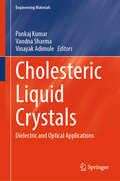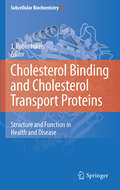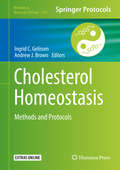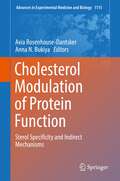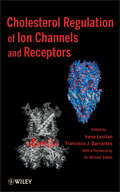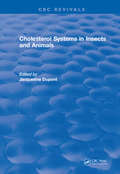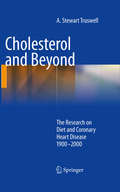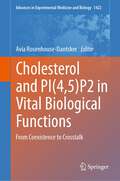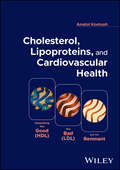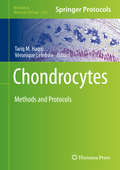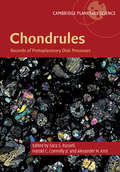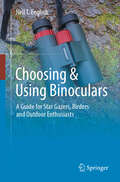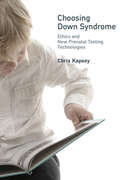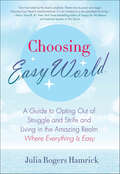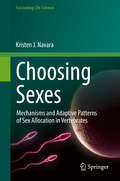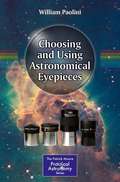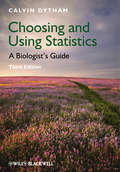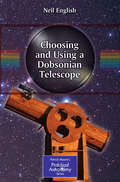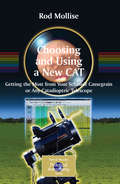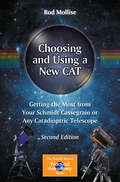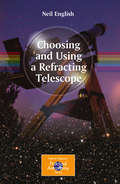- Table View
- List View
Choked: Life and Breath in the Age of Air Pollution
by Beth Gardiner“[An] arresting account of one of the biggest environmental threats to human health.” —Scientific AmericanAir pollution prematurely kills seven million people every year, including more than one hundred thousand Americans. It is strongly linked to strokes, heart attacks, many kinds of cancer, dementia, and premature birth, among other ailments. In Choked, Beth Gardiner travels the world to tell the story of this modern-day plague, taking readers from the halls of power in Washington and the diesel-fogged London streets to Poland’s coal heartland and India’s gasping capital. In a gripping narrative, she exposes the political decisions and economic forces that have kept so many of us breathing dirty air. This is a moving, up-close look at the human toll, where we meet the scientists who have transformed our understanding of pollution’s effects on the body and the ordinary people fighting for a cleaner future.“A compelling book about a critical subject.” —Elizabeth Kolbert, Pulitzer Prize–winning author of The Sixth Extinction“Illuminates some disturbing realities, but it also gives us hope by showing us what we can do to clean our air. . . . An urgent, essential read.” —Arnold Schwarzenegger“Moving . . . By putting a human face on a problem of environmental chemistry, Gardiner shows us the devastation up close, creating a sense of dismay but also urgency to improve lives.” —Washington Post“Timely, eloquent, and disturbing.” —Nature“You couldn’t ask for a better guide for nonspecialists and concerned citizens.” —Guardian, Best Book of the Year“Remarkable.” —Science“Brilliantly reported and beautifully written.” —Anna Clark, author of The Poisoned City
Cholesteric Liquid Crystals: Dielectric and Optical Applications (Engineering Materials)
by Pankaj Kumar Vinayak Adimule Vandna SharmaThis book highlights the latest developments and advancements in cholesteric liquid crystals. It covers a wide range of techniques to develop/modify the cholesteric liquid crystal systems with various optically active chiral dopants. It presents the unexplored features of cholesteric liquid crystals, their diverse properties such as fluorescence, photoluminescence, utility in optical smart windows, optical switching states, energy, and sensor usage with the modification by various carbon-based nanomaterials as intercalating substances. The book examines developments in the field of size and shape of cholesteric liquid crystals. In summary, the book is essential for readers to understand all parameters of cholesteric liquid crystals relating to the device architectures, techniques of formation, optical storage applications, display properties, and various diversified applications in the field of optical smart windows, molecular switches, etc.
Cholesterol Binding and Cholesterol Transport Proteins: Structure and Function in Health and Disease (Subcellular Biochemistry #51)
by J. Robin HarrisKnowledge of cholesterol and its interaction with protein molecules is of fundamental importance in both animal and human biology. This book contains 22 chapters, dealing in depth with structural and functional aspects of the currently known and extremely diverse unrelated families of cholesterol-binding and cholesterol transport proteins. By drawing together this range of topics the Editor has attempted to correlate this broad field of study for the first time. Technical aspects are given considerable emphasis, particularly in relation cholesterol reporter molecules and to the isolation and study of membrane cholesterol- and sphingomyelin-rich "raft" domains. Cell biological, biochemical and clinical topics are included in this book, which serve to emphasize the acknowledged and important benefits to be gained from the study of cholesterol and cholesterol-binding proteins within the biomedical sciences and the involvement of cholesterol in several clinical disorders. It is hoped that by presenting this topic in this integrated manner that an appreciation of the fact that there is much more that needs to be taken into account, studied and understood than the widely discussed "bad and good cholesterol" associated, respectively, with the low- and high-density lipoproteins, LDL and HDL.
Cholesterol Homeostasis
by Ingrid C. Gelissen Andrew J. BrownThis volume provides state-of-the-art techniques for studying various aspects of cholesterol homeostasis, including its uptake, synthesis and efflux from the cell, as well as its trafficking within the cell. Chapters also cover techniques for studying the regulation of cholesterol homeostasis at both the transcriptional and post-translational levels, as well as studying the membrane topology and structure of cholesterol-related proteins. Written in the highly successful Methods in Molecular Biology series format, chapters include introductions to their respective topics, lists of the necessary materials and reagents, step-by-step, readily reproducible laboratory protocols, and tips on troubleshooting and avoiding known pitfalls.Authoritative and practical, Cholesterol Homeostasis: Methods and Protocols aims to provide key techniques in tackling the investigation of cholesterol homeostasis.
Cholesterol Modulation of Protein Function: Sterol Specificity and Indirect Mechanisms (Advances in Experimental Medicine and Biology #1115)
by Avia Rosenhouse-Dantsker Anna N. BukiyaIn this book, renowned scientists describe the role of steroid chirality and modification of lipid membrane physical properties in the modulation of G protein-coupled receptors and ion channels. The application of commonly-used technical approaches such as mass spectrometry and nucleic magnetic resonance transfer spectroscopy for studies on cholesterol distribution and alteration of lipid bilayer characteristics is also discussed. This book offers comprehensive insights into the current understanding of cholesterol-driven modulation of protein function via mechanisms that extend beyond lipid-protein direct interactions. In the first part, the chapters introduce the reader to the use of the chemical derivatives of cholesterol as a valuable laboratory tool in the studies of cholesterol-driven modulation of protein function. In the second part, examples of cholesterol-induced changes in membrane physical characteristics are presented and discussed in light of their multifaceted contribution to the effect of cholesterol on protein function. The book will be of interest to undergraduate and graduate students as well as basic science and medical researchers with a keen interest in the biophysical properties of cholesterol and physiological consequences of cholesterol presence in biological systems.
Cholesterol Regulation of Ion Channels and Receptors
by Francisco Barrantes Irena LevitanExamines new research on the role of cholesterol in regulating ion channels and receptors and its effect on healthDrawing together and analyzing all the latest research findings, this book explores the role of cholesterol in the regulation of ion channels and receptors, including its pathological effects. It is the first book to comprehensively describe the complex mechanisms by which cholesterol regulates two major classes of membrane proteins. Moreover, it sheds new light on how cholesterol affects essential cellular functions such as the contraction of the heart, propagation of nerve impulses, and regulation of blood pressure and kidney function.Written and edited by leading pioneers in the field, Cholesterol Regulation of Ion Channels and Receptors is divided into three parts:Part I, Cholesterol Regulation of Membrane Properties, introduces the heterogeneity of cholesterol distribution in biological membranes and the physical and biological implications of the formation of cholesterol-rich membrane domains.Part II, Cholesterol Regulation of Ion Channels, examines the mechanisms underlying cholesterol sensitivities of ion channels, including the regulation of ion channels by cholesterol as a boundary lipid.Part III, Cholesterol Regulation of Receptors, explores the latest discoveries concerning how cholesterol regulates distinct types of receptors, including G-protein coupled receptors, LDL and scavenger receptors, and innate immune system receptors.Increased levels of cholesterol represent a major health risk. Understanding cholesterol regulation of ion channels and receptors is essential for facilitating the development of new therapeutic strategies to alleviate the impact of pathological cholesterol conditions. With this book as their guide, readers have access to the most current knowledge in the field.
Cholesterol Systems in Insects and Animals
by Jacqueline DupontThe reviews in this collection are unique in their intent to provide a basis for understanding of the subject. They include historical, descriptive, and comparative information which is not always presented in �state of the science� reviews. Cholesterol is viewed in each chapter as part of a system � structural, kinetic, or metabolic. The complex nature of the place of cholesterol in living systems is illustrated in each chapter.
Cholesterol Transporters of the START Domain Protein Family in Health and Disease: START Proteins - Structure and Function
by Barbara J. Clark Douglas M. StoccoNon-vesicular intracellular cholesterol transport is an important mechanism for maintaining membrane cholesterol homeostasis. Recent reports of studies directed at soluble cholesterol transport proteins indicate that aberrant expression of the START proteins may contribute to disease states associated with disorders in cholesterol homeostasis. This is an exciting new direction in the field and the purpose of this book will be to highlight the current research directed at potential roles for the START family in diabetes, cancer and atherogenesis. This book also provides a personal and historical perspective of the discovery-to-publication journey that the authors had for their particular START domain family member. The goal will be to provide perspectives to graduate students, post-doctoral fellows and endocrinology fellows on the research discovery process.
Cholesterol and Beyond: The Research on Diet and Coronary Heart Disease 1900-2000
by A. Stewart Truswell"Only once in a great while does a book come along that really does the job in addressing a major medical issue. When this happens, all can be joyful... Readers will find ALL their favorite dietary puzzlements dealt with... With consummate scholarship, clarity and brevity, Truswell sifts out the chaff and identifies the critical questions, the responsible investigators, and the key studies." So says Emeritus Professor Henry Blackburn from the University of Minnesota in the foreword to this remarkable concise book on the history of research on diet and heart disease. This was a theme of scientific, medical and public interest in the 20th Century, a century marked by the rise and fall of coronary heart disease as the major cause of death in the first world, followed by the rise of this cause of death in the developing world. There is obviously much to learn, and this book is an excellent starting point, tracing dietary factors and their role in heart disease one by one: fats, sugar, salt, alcohol, coffee, trans-fats, etc. Without an understanding of the role of diet and the changes that have been seen in the North American and NW European diet, the story of the decline in the heart disease death rate may have been very different.
Cholesterol and PI: From Coexistence to Crosstalk (Advances in Experimental Medicine and Biology #1422)
by Avia Rosenhouse-DantskerCholesterol is an essential component of the plasma membrane. Phosphatidylinositol 4,5-bisphosphate (PI(4,5)P2), although a minor phospholipid, is the most abundant membrane phosphoinositide. Both lipids play key roles in a variety of cellular functions including as signalling molecules and major regulators of protein function. Studies on these important lipids have traditionally focused on the effect of each lipid individually. Accumulating evidence indicates, however, that these lipids may cross-regulate each other’s levels. Furthermore, it is becoming evident that cholesterol and PI(4,5)P2 can act together to modulate protein function and biological processes. This book provides an overview of cellular functions and molecular mechanisms in which cholesterol and PI(4,5)P2 functions extend from parallel existence to crosstalk. It includes four sections. The first section introduces the reader to cholesterol and PI(4,5)P2. The second section demonstrates the mutual influence of these two critical lipids on their levels. The third section, divided into two parts, describes the co-modulation of protein function by cholesterol and PI(4,5)P2. The first part focuses on ion channels and the second - on lipid transfer proteins. The fourth section highlights other cellular processes at the intersection of cholesterol and PI(4,5)P2 involvement. Collectively, the book portrays the emerging relationship between cholesterol and PI(4,5)P2 in a broad array of biological systems and processes. The book will be of interest to a wide audience of research scientists with an interest in the biophysical properties of lipids and the physiological consequences of their presence in biological systems, as well as graduate students, postdoctoral trainees, basic and clinical researchers, and pharmaceutical scientists. Specifically, the content will be relevant to researchers in the fields of biochemistry, molecular biophysics, pharmacology, neurobiology, cardiovascular biology, among others.Provides a comprehensive overview of the current knowledge of the interplay between cholesterol and PI(4,5) P2Provides an overview of the emerging relationship between cholesterol and PI(4,5)P2 in biological systems and processesDiscusses cellular processes and molecular mechanisms where lipid functions extend from parallel existence to crosstalk
Cholesterol, Lipoproteins, and Cardiovascular Health: Separating the Good (HDL), the Bad (LDL), and the Remnant
by Anatol KontushDiscover the biology, biochemistry, and medical aspects of lipoproteins in this comprehensive overview of its historic and contemporary development The fatty substance known as cholesterol is found in every cell of the human body and carries out several important functions. It is transported through the bloodstream as a part of particles called lipoproteins, which are divided into classes including low-density lipoprotein (LDL) and high-density lipoprotein (HDL). Distinguishing between these two classes, along with the ‘remnant cholesterol’ particles that have recently been associated with heightened risk of heart disease and stroke, is a crucial part of managing health and developing novel pharmaceuticals. Cholesterol, Lipoproteins, and Cardiovascular Health offers a thorough and rigorous overview of these particles, their properties, and their methods of categorization. Surveying both the characteristics of lipoproteins and their interactions with diet, lifestyle, therapeutics, and general health, it’s an indispensable guide to these particles that can literally mean the difference between life and death. Cutting-edge and grounded in the latest research, it’s a one-stop shop for understanding blood plasma lipoproteins in all their major forms. Cholesterol, Lipoproteins, and Cardiovascular Health readers will also find: Detailed discussion of topics including basic lipoprotein biochemistry, targeted therapeutics and drug development, and many moreEasily readable overview of the current state of research into lipoproteins and their likely future applicationsRich illustrative material enhanced by a graphical abstract at the beginning of each section offering a summary of crucial content Cholesterol, Lipoproteins, and Cardiovascular Health is suited for professionals, clinicians, and readers looking for a comprehensive overview of all aspects of plasma lipoproteins and their role in heart disease and stroke.
Cholesterol-Lowering Therapy: Evaluation of Clinical Trial Evidence
by Scott M. GrundyReveals important new results from clinical trials conducted in Scandinavia, Scotland, Australia, Canada, and the United States.This timely reference reviews the vast body of clinical trial evidence supporting the once controversial view that high levels of serum cholesterol are a major risk factor in coronary heart disease (CHD). The studies p
Chomp: A Shark Romp
by Michael PaulDive in to the depths of the ocean to discover different species of sharks in this nonfiction picture book with simple text and illustrations.Many different kinds of sharks are swimming below the ocean's surface.Some sharks are gentle, and some sharks are fierce. Some are awake in the day, and some are awake at night. Some eat almost anything, and some are very picky.You may not be able to visit their watery world, but you can always visit them up close at the aquarium.Simple text and bold illustrations take young explorers on a deep dive through the ocean full of sharks.Don't Miss More from Michael Paul in Roar: A Dinosaur Tour!
Chondrocytes: Methods and Protocols (Methods in Molecular Biology #2245)
by Tariq M. Haqqi Véronique LefebvreThis detailed book collects a variety of methods from investigators at the forefront of chondrocyte biology and pathology research that they have tailored for their research projects in order to tackle the unique properties and challenges of the chondrocyte and those of its tissue matrix. Divided into three parts, the volume explores experimental models to study chondrocytes, in vivo assays, as well as methods to characterize the chondrocyte phenotype with high-throughput or discrete assays on cells maintained in vivo, just isolated from their tissue (ex vivo), or cultured in vitro. Written in the highly successful Methods in Molecular Biology series, chapters include introductions to their respective topics, lists of the necessary materials and reagents, step-by-step, readily reproducible laboratory protocols, and tips on troubleshooting and avoiding known pitfalls. Authoritative and cutting-edge, Chondrocytes: Methods and Protocols is an ideal guide for experts as well as newcomers in the cartilage field with the aim of sparking new research ideas in order to solve many of the pending mysteries regarding cartilage biology, disease mechanisms, and potential treatments.
Chondrules: Records of Protoplanetary Disk Processes (Cambridge Planetary Science #22)
by Sara S. Russell Harold C. Connolly Jr. Alexander N. KrotChondrules are spherical silicate grains which formed from protoplanetary disk material, and as such provide an important record of the conditions of the Solar System in pre-planetary times. Chondrules are a major constituent in chondritic meteorites, however despite being recognised for over 200 years, their origins remain enigmatic. This comprehensive review describes state-of-the-art research into chondrules, bringing together leading cosmochemists and astrophysicists to review the properties of chondrules and their possible formation mechanisms based on careful observations of their chemistry, mineralogy, petrology and isotopic composition. Current and upcoming space missions returning material from chondritic asteroids and cometary bodies has invigorated research in this field, leading to new models and observations, and providing new insight into the conditions and timescales of the solar protoplanetary disk. Presenting the most recent advances, this book is an invaluable reference for researchers and graduate students interested in meteorites, asteroids, planetary accretion and solar system dynamics.
Choosing & Using Binoculars: A Guide for Star Gazers, Birders and Outdoor Enthusiasts
by Neil T. EnglishBinoculars are life enhancing instruments, uniquely capable of bringing the intricacies of nature into sharp focus. Whether it be birds, majestic lakes and seas, alpine vistas, wild animals or exploring the glories of the night sky, anyone interested in buying binoculars today will be faced with a bewildering number of different models to choose from! This book walks the reader through the fascinating world of binoculars, past and present, while exploring all of the main binocular types, their desirable features, how to test out and narrow down the choices a prospective customer should make, as well as looking at some of the best and most-sought-after binoculars money can buy. Uniquely experienced writer and binocular enthusiast, Dr Neil English, takes the pain out of narrowing down the search for your ideal binocular, whether your budget is $50 or $5,000. Dr English explores many of the timeless beauties of the binocular world, crafted by top European and Japanese manufacturers, such as Swarovski, Zeiss, Nikon, Leica and others. Sumptuously illustrated throughout with full color images, Choosing & Using Binoculars decodes all the technical jargon without sacrificing accuracy and presents the world’s best compendium of binocular literature for the birder, hunter, inveterate traveler, nature enthusiast and star gazer. Don’t leave home without it!
Choosing Down Syndrome: Ethics and New Prenatal Testing Technologies (Basic Bioethics)
by Chris KaposyAn argument that more people should have children with Down syndrome, written from a pro-choice, disability-positive perspective.The rate at which parents choose to terminate a pregnancy when prenatal tests indicate that the fetus has Down syndrome is between 60 and 90 percent. In Choosing Down Syndrome, Chris Kaposy offers a carefully reasoned ethical argument in favor of choosing to have such a child. Arguing from a pro-choice, disability-positive perspective, Kaposy makes the case that there is a common social bias against cognitive disability that influences decisions about prenatal testing and terminating pregnancies, and that more people should resist this bias by having children with Down syndrome.Drawing on accounts by parents of children with Down syndrome, and arguing for their objectivity, Kaposy finds that these parents see themselves and their families as having benefitted from having a child with Down syndrome. To counter those who might characterize these accounts as based on self-deception or expressing adaptive preference, Kaposy cites supporting evidence, including divorce rates and observational studies showing that families including children with Down syndrome typically function well. Himself the father of a child with Down syndrome, Kaposy argues that cognitive disability associated with Down syndrome does not lead to diminished well-being. He argues further that parental expectations are influenced by neoliberal ideologies that unduly focus on the supposed diminished economic potential of a person with Down syndrome.Kaposy does not advocate restricting access to abortion or prenatal testing for Down syndrome, and he does not argue that it is ethically mandatory in all cases to give birth to a child with Down syndrome. People should be free to make important decisions based on their values. Kaposy's argument shows that it may be consistent with their values to welcome a child with Down syndrome into the family.
Choosing Easy World: A Guide to Opting Out of Struggle and Strife and Living in the Amazing Realm Where Everything Is Easy
by Julia Rogers Hamrick"Don't be fooled by this book's simplicity: therein lies its power and magic! Choosing Easy World is transformational. It is an invitation to a new paradigm for living." —Marci Shimoff, #1 New York Times bestselling author and featured teacher in The Secret Contrary to what we've believed, life does not have to be hard. And it was never intended to be! Choosing Easy World explores the concept that we can access a place where everything works out effortlessly, harmoniously, and in support of our highest possibilities for well-being. As its title implies, Choosing Easy World reveals that the key to being in this reality—in "Easy World"—is as simple and easy as choosing to be. Woven throughout with powerful personal stories of opting into Easy World with remarkable results, Choosing Easy World provides readers with inspiration, instructions, and support for doing so themselves. In this book, you will learn: • How eleven simple words can take you to Easy World • True stories of people who have used the Easy World technique to change their lives • The differences between Difficult World and Easy World • What to do when Choosing Easy World seems impossible • How to Choose Easy World even under the worst of circumstances • And many more techniques and stories using these powerful tools. Choosing Easy World not only gives you the secret to getting to this amazing alternate reality even in the most challenging of times, it teaches you how to transcend the Difficult World-addicted aspect of your mind and contains a wealth of practical, leading-edge strategies for supporting your Easy World existence. This life-transforming book is for everyone who• Is experiencing problems with finances, career, relationships, or any facet of life• Is tired of trying hard but feeling as though they're getting nowhere• Isn't experiencing joy as their usual state of being• Feels overwhelmed by their never-ending to-do list with all its shoulds and ought-tos• Is tired of doing things they're not passionate about, or even suited for, just to pay the bills.• Yearns to discover their life purpose and fulfill it• Is longing for contentment and inner peace—outer peace, too
Choosing Sexes
by Kristen J. NavaraThere is extensive evidence that vertebrates of all classes have the ability to control the sexes of the offspring they produce. Despite dramatic differences in the mechanisms by which different taxa determine the initial sex of offspring, each group has found its own way of adjusting offspring sex ratios in response to social and environmental cues. For example, stress is a well-known modulator of offspring sex in members of all groups studied to date. Food availability, and limitation in particular, is another common cue that stimulates biases in offspring sex ratios in a wide variety of species. Offspring sex can be adjusted at the primary level, which occurs prior to conception, or at the secondary level, during embryonic development. While the mechanistic pathways that ultimately result in sex ratio biases and the developmental time-points sensitive to those mechanisms likely differ among taxa, the key involvement of steroid hormones in the process of sex ratio adjustment appears to be pervasive throughout. This book reviews the systems of sex determination at play in different vertebrate groups, summarizes the evidence that members of all vertebrate taxa can facultatively adjust offspring sex, and discusses when and how these adjustments can take place.
Choosing and Using Astronomical Eyepieces (The Patrick Moore Practical Astronomy Series)
by William PaoliniA valuable reference that fills a number of niches including that of a buyer's guide, technical desk reference and observer's field guide. It documents the past market and its evolution, right up to the present day. In addition to appealing to practical astronomers - and potentially saving them money - it is useful both as a historical reference and as a detailed review of the current market place for this bustling astronomical consumer product. What distinguishes this book from other publications on astronomy is the involvement of observers from all aspects of the astronomical community, and also the major manufacturers of equipment. It not only catalogs the technical aspects of the many modern eyepieces but also documents amateur observer reactions and impressions over the years, using many different eyepieces. Eyepieces are the most talked-about accessories and collectible items available to the amateur astronomer. No other item of equipment commands such vigorous debate, or has evolved into such a remarkable array of forms and functions. 'Choosing and Using Astronomical Eyepieces' provides a vast amount of reference material to point readers towards the best buys and the right eyepieces for different kinds of observing.
Choosing and Using Statistics
by Calvin DythamChoosing and Using Statistics remains an invaluable guide for students using a computer package to analyse data from research projects and practical class work. The text takes a pragmatic approach to statistics with a strong focus on what is actually needed. There are chapters giving useful advice on the basics of statistics and guidance on the presentation of data. The book is built around a key to selecting the correct statistical test and then gives clear guidance on how to carry out the test and interpret the output from four commonly used computer packages: SPSS, Minitab, Excel, and (new to this edition) the free program, R. Only the basics of formal statistics are described and the emphasis is on jargon-free English but any unfamiliar words can be looked up in the extensive glossary. This new 3rd edition of Choosing and Using Statistics is a must for all students who use a computer package to apply statistics in practical and project work.Features new to this edition:Now features information on using the popular free program, RUses a simple key and flow chart to help you choose the right statistical testAimed at students using statistics for projects and in practical classesIncludes an extensive glossary and key to symbols to explain any statistical jargonNo previous knowledge of statistics is assumed
Choosing and Using a Dobsonian Telescope (The Patrick Moore Practical Astronomy Series #1)
by Neil EnglishIn the 1960's, American amateur astronomer, John Dobson, designed a revolutionary kind of astronomical telescope featuring a lightweight large-aperture reflecting system on a simple mounting, using the then-revolutionary material called teflon. The design combines simplicity and portability with large-aperture prowess. Thirty years later Dobsonians remain supreme for visually observing faint deep-sky objects and are one of the best-selling large telescopes in the USA and Europe. This popularity is reflected in the recent increase of companies now heavily marketing Dobsonians, in particular, Meade (the "Lightbridge" range), Orion USA (XT Intelliscope series), and Skywatcher (Skyliner and Flextube models). This book is the ultimate guide to buying and using commercial Dobsonians, both 'Econo' and 'Primo' models, with in-depth accounts for the various models (plus accessories) on the market and descriptions of the many innovations that amateurs have made to optimize their telescopes' performance.
Choosing and Using a New CAT: Getting the Most from Your Schmidt Cassegrain or Any Catadioptric Telescope (The Patrick Moore Practical Astronomy Series)
by Rod MolliseChoosing and Using the New CAT will supersede the author's successful Choosing and Using a Schmidt-Cassegrain Telescope, which has enjoyed enthusiastic support from the amateur astronomy community for the past seven years. Since the first book was published, a lot has changed in the technology of amateur astronomy. The sophistication and variety of the telescopes available to amateurs has increased dramatically. Computerized SCTs, Maksutov-Cassegrains, and most recently Meade's new and acclaimed Ritchey-Chrétiens have come to dominate the market. That means that all amateurs considering the purchase of a new telescope (not only a SCT, and not just beginners) will benefit from this detailed guide. Choosing the right telescope for particular kinds of observation (or even for general work) is far from easy - but Rod Mollise gives invaluable advice and guidance.
Choosing and Using a New CAT: Getting the Most from Your Schmidt Cassegrain or Any Catadioptric Telescope (The Patrick Moore Practical Astronomy Series)
by Rod MolliseCatadioptric telescopes (CATs) such as the Schmidt Cassegrains remain popular among amateur astronomers for their ability to reveal thousands of beautiful deep-space wonders. Additionally, their computer-assisted capabilities allow them to automatically point to and track celestial objects, making astronomy accessible to more people than ever before. However, selecting the right one and learning how to use it can be difficult for stargazers both old and new. That’s where this book comes in. The first edition, published in 2009, has remained the standard reference for mastering these popular instruments. This revised edition brings the material completely up to date, with several extensively rewritten chapters covering the most recent developments in telescope and camera equipment as well as computer software.Through the author’s 45 years of experience with catadioptric telescopes, readers will learn to decide which catadioptric telescope is right for them, to choose a specific make and model, and finally, to use the telescope in the field. Covered in other chapters are: Solar System and deep-sky observations; astrophotography and computer control of CATs; and troubleshooting and maintaining your equipment.If you dream of owning a telescope or are frustrated by the telescope you already own, this is the book for you!
Choosing and Using a Refracting Telescope (The Patrick Moore Practical Astronomy Series)
by Neil EnglishChoosing and Using a Refracting Telescope has been written for the many amateur astronomers who already own, or are intending to purchase, a refracting telescope - perhaps to complement their existing arsenal of larger reflecting telescopes - or for the specialist who requires a particular refractor for serious astronomical applications or nature studies. Four hundred year ago, during the winter of 1609, a relatively unknown Italian scientist, Galileo Galilei designed a spyglass with two crude lenses and turned it skyward. Since then, refractors have retained their dominance over all types of reflector in studies of the Moon, planets and double stars because of the precision of their optics and lack of a central obstruction in the optical path, which causes diffraction effects in all commercially-made reflectors. Most mature amateur astronomers got started with a 60mm refractor, or something similar. Thirty years ago, there was little choice available to the hobbyist, but in the last decade long focus crown-flint achromats have moved aside for some exquisitely crafted apochromatic designs offered by leading commercial manufacturers. There has been a huge increase in the popularity of these telescopes in the last few years, led by a significant increase in the number of companies (particularly, William Optics, Orion USA, StellarVue, SkyWatcher and AstroTech) who are now heavily marketing refractors in the amateur astronomical magazines. In Choosing and Using a Refracting Telescope, well-known observer and astronomy writer Neil English celebrates the remarkable history and evolution of the refracting telescope and looks in detail at the instruments, their development and their use. A major feature of this book is the way it compares not only different classes of refractor, but also telescopes of each class that are sold by various commercial manufacturers. The author is perhaps uniquely placed to do this, having used and tested literally hundreds of different refracting telescopes over three decades. Because it includes many diverse subjects such as imaging with consumer-level digital cameras, imaging with webcams, and imaging with astronomical CCD cameras - that are not covered together in equal depth in any other single volume - Choosing and Using a Refracting Telescope could become the 'refractor bible' for amateur astronomers at all levels, especially those who are interested in imaging astronomical objects of every class.

